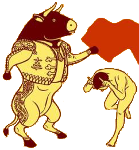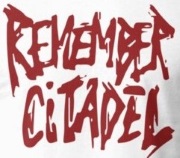|
baka kaba posted:Just to hammer it home - the CAGED system uses those 5 chord shapes, and each of those shapes has the root notes on certain strings. For example the C shape has its roots (the C notes) on the 2nd and 5th strings rio posted:
Hey, thanks for all the good info here. I feel like I have a decent grasp of chords and scales individually, but putting them together in a practical sense has been like trying to pat my head and rub stomach at the same time. I think I've got it a bit better now, so it's time to spend the next week or so playing with them to see if I really do understand it.
|
|
|
|

|
| # ? May 9, 2024 04:17 |
|
Well this isn't so much about chords and scales in general, it's more about the CAGED system itself. If you look at rio's diagram:
So there are only 5 scale patterns to learn, each one has a chord shape in it, and wherever you are there are only two choices of which to use. Once you're in position, you have a scale and a chord right under your fingers, and you can move to one of the adjacent shapes if you want to shift up or down the neck Like you posted there are other box patterns that fit halfway between these CAGED ones, but they're not used here. This is like a stripped-down and simplified system that still gives you everything you need - you always have a scale and its tonic chord exactly where you are. You're trading off a bit of flexibility but you can always add in those other positions and other concepts once you have a solid grounding
|
|
|
|
The hardest part about the CAGED system is that once you get it all down and perfect you just want to stay in those prescribed 4-5 fret boxes and it's not natural to do weird poo poo that overlaps between two chunks. A good way to break that is to practice things that need to jump between chunks, IE anything that requires short position changes. Otherwise you end up doing poo poo like Kirk Hammet does where you never really have to move your thumb for stuff.
|
|
|
|
That's so he can always be giving everyone a thumbs up
|
|
|
|
baka kaba posted:Well this isn't so much about chords and scales in general, it's more about the CAGED system itself. If you look at rio's diagram: Yeah, declaring that this made me understand the relationship between chords and scales was a bit of hyperbole. Currently I'm fairly comfortable with the scale box shapes I've posted, and I'm comfortable finding basic major and minor chords, but I can't combine those two ways of thinking. If you asked me to play two bars of rhythm, then one bar of a simple lead pattern, then go back to rhythm there'd be a noticeable pause between those sections as my brain tried to switch gears. Having some simple overlap in chord and scale shapes seems like it would help to break down that barrier I have between the two types of playing. I'd imagine that over time and with lots of practice the need for that overlap would go away, but I'm looking for a good starting point. Does that sound right, or am I misunderstanding this still?
|
|
|
rio posted:Short scale strings are actually too short for the Douglass because it has a tailpiece which extends the string length. I use black tapewound D'Addarios and they work very well on the bass for what I want from it. If I'm looking at the D'Addario NYXL Bass strings, which set am I going to want? I really like the NYXL on my guitar, so if I can I'd like to just stick with those for my bass
|
|
|
|
|
Hellblazer187 posted:Awesome guys, I'd never looked at guitarfetish, and looking at the SD site I was wondering whether putting a $100 pickup made sense in a <$100 guitar. The dream 180 seems like it might be a good fit but I'll check out their other options. While I'm doing all this, I may just update the tuners also.... I can also vouch for the Dream 180. It sounds great clean while still sounding really good distorted. Does anyone have any experience with the Surf 90? I built a guitar using all GFS XGP parts this weekend (grand total, after loving up the first body, including all tax and shipping was a little under $500) with a Mean 90 in the neck and Surf 90 in the bridge. The Mean 90 works perfectly, but, for some reason I can't wrap my head around, the volume pot does nothing with the Surf 90, and the tone pot functions as a volume knob for it. What's weird is that both pickups are wired into the switch, with the switch outputting to the volume pot. It's not a total dealbreaker for me, since the pickups sound great, but that's a weird rear end wiring issue. For the record, the Mean 90 sounds like a p90 mixed with a little bit of an acoustic guitar, while the Surf 90 sounds like the bridge of a strat mixed with a p90, and the guitar came out really well for a first time build.
|
|
|
|
plerocercoid posted:Yeah, declaring that this made me understand the relationship between chords and scales was a bit of hyperbole. Currently I'm fairly comfortable with the scale box shapes I've posted, and I'm comfortable finding basic major and minor chords, but I can't combine those two ways of thinking. If you asked me to play two bars of rhythm, then one bar of a simple lead pattern, then go back to rhythm there'd be a noticeable pause between those sections as my brain tried to switch gears. Having some simple overlap in chord and scale shapes seems like it would help to break down that barrier I have between the two types of playing. I'd imagine that over time and with lots of practice the need for that overlap would go away, but I'm looking for a good starting point. That's what this CAGED thing helps with! So basic theory - you've got a major scale, it has 7 different notes in it (that end up repeating, just higher versions). To make a major chord from that scale, you need to pick out the roots, 3rds and 5ths in that scale. Those are the 'chord tones' rio highlighted in his diagram, the tones that make up the major chord. (You make other kinds of chords by using a different recipe of tones from the scale, but worry about that later!) So a chord is really picking out some important notes from a scale pattern, and fretting them all at once. The scale pattern is still there, you're just focusing on certain notes in it. It's a bit like how you ignore notes to create a pentatonic scale, in a way Instead of having to work out where all those chord tones are and how you can finger them to make a chord, it's good to have an associated shape that you're familiar with. And that's how these scale and chord shapes relate - the C 'scale shape' contains the pattern of chord tones that fits the C 'chord shape' you know and love. That shape just slots over the scale pattern to give you the notes you need. You don't need to think about this - if you're noodling over a particular box pattern, you can jump straight to the one chord that pairs with it, so just practice switching between the two. Play a bit of lead in that pattern, then switch to the chord, then some lead again. Try leading into one of the chord's tones, or bounce around them individually before you play them all together as a chord. It's something you need to practice, both for the dexterity and making it sound musical I guess some people can spend their life in the CAGED system and that's great, it simplifies things and gives you a bit of structure to stop you getting lost. But even if you want to break out of it (which you probably will, playing rock music) it gives you familiarity with the fretboard, the ability to make a chord anywhere, and an understanding of how chords are made and what this thing you just played actually is
|
|
|
|
nickhimself posted:If I'm looking at the D'Addario NYXL Bass strings, which set am I going to want? I really like the NYXL on my guitar, so if I can I'd like to just stick with those for my bass Medium or standard scale - I forget which word D'Addario uses for it. One thing to keep in mind is that round wounds will dig into the fingerboard a bit since it isn't ebony or a coated rosewood (or coated maple or anything else other than ebony or synthetic material). How much wear depends on how hard you press down the strings and how much you play so you may not see much wear after a year or you may see some groves starting to appear in the fingerboard.
|
|
|
rio posted:Medium or standard scale - I forget which word D'Addario uses for it. One thing to keep in mind is that round wounds will dig into the fingerboard a bit since it isn't ebony or a coated rosewood (or coated maple or anything else other than ebony or synthetic material). How much wear depends on how hard you press down the strings and how much you play so you may not see much wear after a year or you may see some groves starting to appear in the fingerboard. Uh... I don't want to do that. Is that a symptom of the strings, or the fretboard itself? If it's the former, could you link a set of strings you'd recommend over the NYXL? If it's the latter, how can I prevent that?
|
|
|
|
|
OutOfPrint posted:I can also vouch for the Dream 180. It sounds great clean while still sounding really good distorted. I doubt the pickup is broken. I have a feeling you may have just managed to wire it up wrong. Do you have a link to what diagram you are going by? Can you upload a picture of what the wiring you have looks like? Is it volume/tone and the guitar is acting more like volume/volume? Do you have a second tone pot? Does the tone pot also roll off the treble on the Mean 90 or just the volume on the Surf 90? I had a weird wiring issue like sounds similar to that, but I could never quite figure out. I plan to sell the guitar as-is, so I don't want to spend any more time or effort dealing with it. Standard strat wiring with volume, tone, tone. The master volume works fine, but the middle pickup volume drops out when rolling back either tone control. I have one tone wired to neck and the other wired to bridge, which could be part of the issue, but I am pretty sure I had the same problem when it was wired neck tone, mid tone. For all I know, it could just a be a short in the 5-way switch. I didn't have any replacement caps or pots of the right values. I could have soldered out some pots and caps meant for humbuckers from a different pickguard, but like I said, I didn't really want to spend more effort on it. The guitar has mini-pots, which could be part of the problem as well. I have read they are more easily damaged by the heat from soldering, but have no personal experience with that. I don't know what a heat damaged pot behaves like.
|
|
|
|
Anime Reference posted:Being able to capo the 4th fret and have a normal 25.5" guitar would be a neat feature. Wasn't there a steinberger that did exactly that at some point? Here it is. http://www.steinberger.com/ST2FPA.html
|
|
|
|
OutOfPrint posted:I can also vouch for the Dream 180. It sounds great clean while still sounding really good distorted. So, I can't answer your question, but I have a question for YOU. What tools did you need for the kit build? I was thinking gosh, if I'm thinking of updating all this stuff maybe a kit build is just the way to go. Did you have a good guide to use for making sure you didn't ruin everything?
|
|
|
|
Gripen5 posted:I doubt the pickup is broken. I have a feeling you may have just managed to wire it up wrong. Do you have a link to what diagram you are going by? Can you upload a picture of what the wiring you have looks like? Is it volume/tone and the guitar is acting more like volume/volume? Do you have a second tone pot? Does the tone pot also roll off the treble on the Mean 90 or just the volume on the Surf 90? I can't crack it open right now since I'm at work, but here's the quick rundown: There are six components in play: two pickups, a 3-way telecaster switch, two pots (one tone, one volume), and the jack itself, with another ground connection going to the tremolo screw plate. code:The Surf 90 in the bridge has a two wire hookup: one hot wire going to the switch, and a braided silver cable which goes to ground. The volume pot does nothing, the tone pot rolls down volume. The three way telecaster switch is wired to go directly to the volume pot on lug 1 (I think. I don't know my lug numbers, but I know that turning down the pot turns down the volume on the Mean 90), which is also connected to the tone pot. The tone pot has a standard .047 cap on it. The pots interact with the Mean 90 exactly as intended. The Surf 90 is the only pickup affected by this. If it were both pickups, that'd be an easy fix. Considering it's one pickup and how they're hooked up, I'm stumped. Don't get me wrong, I love this guitar and how the pickups sound with the volume and tone dimed, so I'm not disappointed at all in how it turned out. This is just a weird issue I ran into, and if anyone could give me some insight as to what's happening, I'd appreciate it. Incidentally, I burned a tone pot before on a different guitar. It warped something in the pot so that rolling it off did very little until it hit 2 on the dial, and then, WHAM, no more treble.
|
|
|
|
OutOfPrint posted:I can't crack it open right now since I'm at work, but here's the quick rundown: Going to need a picture really because there's nothing there that should stop the circuit working as expected. If you've hooked the output of the switch to the volume pot correctly and you're getting signal from both pickups then they should behave identically.
|
|
|
|
nickhimself posted:Uh... I don't want to do that. Is that a symptom of the strings, or the fretboard itself? If it's the former, could you link a set of strings you'd recommend over the NYXL? If it's the latter, how can I prevent that? It's both, kind of. Jaco was the first person to do fretless and he did it by taking the frets out of his jazz bass. He wanted to use roundwounds and maple is too soft to take them without damaging the neck over time so he used boat epoxy on the fingerboard. This provided a strong surface for the strings that wouldn't dig into the wood. Ebony is used on string instruments (as in orchestra strings) for a bunch of reasons but one is because it is hard enough to resist strings being pressed against it all the time without damaging the wood. Rosewood can take flatwound strings too but something like maple is too soft to use by itself for any kind of strings. The Douglas fingerboard is rosewood so any kind of flatwound string will be safe. Standard flats like steel ones (which is most of the brands that make them), nickel (Thomastik Infeld, which is my favorite flatwound - they are pricey but last forever) and nylon tapewound strings, which is what I use on my Douglas. Specifically the D'Addario nylon tapewounds. They are cheap and good. Really it is just that roundwounds have tiny little surfaces that will dig into the strings. Flats of any kind have one surface area that touches the string when you press it down so the board will be safe.
|
|
|
|
OutOfPrint posted:I can't crack it open right now since I'm at work, but here's the quick rundown: Mean 90 has 4 wires? Are you sure? Is it maybe a different pickup? I have a mean 90 and it just has two plus grounding wire, although that was before their quickplug system. But I would think a single coil would just have hot, ground, and the braided ground like the Surf 90. I have a feeling that is not the problem. Might be either the 3-way switch being wired incorrectly, or a maybe an internal short in it? Pictures would definitely help when you get a chance. Probably just something silly. This should be the diagram you should be using right off Seymour Duncan's site. https://docs.google.com/gview?embedded=true&url=http%3A%2F%2Fwww.seymourduncan.com%2Fwp-content%2Fuploads%2F2016%2F05%2F2H_3B_1V_1T.pdf Gripen5 fucked around with this message at 20:19 on Aug 28, 2017 |
|
|
|
OutOfPrint posted:
 That would mess me up so bad.
|
|
|
|
Is it considered lazy to use weird chords that other bands use? Vektor has some awesome dissonant chords and some interesting triad ideas that I don't mean to purposefully try to incorporate in stuff but some of them just work so well in places.
|
|
|
|
I think we've all 'invented' a chord or tuning for our inevitable guitar magazine interview Yoink away, friend!
|
|
|
|
Spanish Manlove posted:Is it considered lazy to use weird chords that other bands use? Vektor has some awesome dissonant chords and some interesting triad ideas that I don't mean to purposefully try to incorporate in stuff but some of them just work so well in places. All english poets draw from the same dictionary of words without being automatically unoriginal.
|
|
|
|
Head and Munky refer to flattened fifth chords as the "Bungle Chord" because they believed they were stealing it from Mr Bungle. If I play it and put an additional octave on top my brain refers to it as a "Dillinger chord"
|
|
|
|
Spanish Manlove posted:Is it considered lazy to use weird chords that other bands use? Vektor has some awesome dissonant chords and some interesting triad ideas that I don't mean to purposefully try to incorporate in stuff but some of them just work so well in places. Steal everything cool from the people who found it first.
|
|
|
|
Hellblazer187 posted:So, I can't answer your question, but I have a question for YOU. What tools did you need for the kit build? I was thinking gosh, if I'm thinking of updating all this stuff maybe a kit build is just the way to go. Did you have a good guide to use for making sure you didn't ruin everything? Tools I used to build my kits: Screwdrivers Allen key (for truss rod) Soldering iron Drill Sandpaper More sandpaper Holy gently caress, I can't believe I'm heading out to get more sandpaper Crescent wrench (tuners / jack)
|
|
|
|
NonzeroCircle posted:Head and Munky refer to flattened fifth chords as the "Bungle Chord" because they believed they were stealing it from Mr Bungle. Funny you should mention it because the specific chord I wanna steal is basically the dillinger chord played x45600 low to high and is used a bunch in Ultimate Artificer https://www.youtube.com/watch?v=WNmHtWERWyw I think it's the second chord. But awesome, thanks you guys. Now I don't feel so bad about using the Abbath octaves that are 138 (scale degree, not frets) in everything.
|
|
|
|
NonzeroCircle posted:Head and Munky refer to flattened fifth chords as the "Bungle Chord" because they believed they were stealing it from Mr Bungle. who? edit: oh lol korn
|
|
|
|
I just learned Korn was cribbing from Mr Bungle, what a day Although it puts Jonathan Davis's vocal stylings into perspective
|
|
|
|
Yep, they were obsessed with Trey Spruance. Trey produced Head's solo album saying Head was the weirdest dude he ever met, Mr. Bungle fan-boy not withstanding.
|
|
|
|
That's weird as hell, but cool. I went on YouTube hoping they covered Platypus or something but no 😔
|
|
|
|
Spanish Manlove posted:Funny you should mention it because the specific chord I wanna steal is basically the dillinger chord played x45600 low to high and is used a bunch in Ultimate Artificer
|
|
|
|
If I'm in drop tuning I really have to try hard not to use the Devin Octave (ie played on the bottom two strings) otherwise I lose focus and play SYL stuff instead of whatever it was I was doing. Its fun if you can do it off the first fret of the lowest string (and sixth on the next) cos it sounds like a drat tuba. Stretch city on the fingers though. Edit https://www.youtube.com/watch?v=rSB44KR28JY Its kinda Bungley I guess. Warning, epitome Davis lyrics NonzeroCircle fucked around with this message at 00:15 on Aug 29, 2017 |
|
|
|
How do you guys (rio) feel about the Alain Benbassat method? I finally sucked it up and starting doing daily ear training with it using the iOS app "Functional Ear Training". The app is great so far but it's a little dense even with the logical layout.
|
|
|
|
nickhimself posted:Uh... I don't want to do that. Is that a symptom of the strings, or the fretboard itself? If it's the former, could you link a set of strings you'd recommend over the NYXL? If it's the latter, how can I prevent that? Did you get a fretless? If you didn't, don't worry about it. The frets will take the abuse rather than the fretboard.
|
|
|
|
Anime Reference posted:Did you get a fretless? If you didn't, don't worry about it. The frets will take the abuse rather than the fretboard. Oh that is a good point that I forgot to ask. I got the fretless one as did the couple students I have who got them after seeing mine. I forgot that they make fretted ones and also forgot if he got a fretted or fretless now...I think it was fretless but yeah the strings wouldn't matter for a fretted.
|
|
|
|
Recording video & audio at the same time[edit] I just realized I can put this question in the Home Recording thread, I'll move it there. While I've got a post though... I'm worried about hanging my guitars again, despite having them hanging for the past 2 years ( although I've since fully cycled through all 3 into different models in the past year ). I have them hanging more for aesthetics and to keep stuff off the floor ( wife requirement ), and since every guitar store ever seems to have them hanging I figured NBD. But since I've been recording and playing through my computer a lot more, I tend to keep my primary guitar on a basic stand/rest just like this:  Right beside my desk/computer and generally always plugged in. I've noticed since I started doing this, that after sitting for awhile and being in tune, if I hang it for a day the tuning goes quite sharp, probably 1/4 semitone. If I then re-tune, and sit it again then after another day the tuning goes slightly flat, probably 1/8 semitone ( roughly ). So my concern is the bowing of the neck being so dramatically ( to me ) affected by these changes in position. Should I do either or - like either hang always, or sit always? Or is this kind of sharp/flat scenario not that big of a deal? Is it always going to be a case where how you store the guitar is going to affect the bow of the neck in some way, and that's just the way it is? Should I keep it in an anti-gravity compartment?? TollTheHounds fucked around with this message at 02:58 on Aug 29, 2017 |
|
|
|
Kilometers Davis posted:How do you guys (rio) feel about the Alain Benbassat method? I finally sucked it up and starting doing daily ear training with it using the iOS app "Functional Ear Training". The app is great so far but it's a little dense even with the logical layout. I haven't used that method or app so it is my lucky day where I get to check out two new teaching tools. Methods, in particular, are hard to find because I have seen a lot so finding one I am not familiar with is awesome. I'm going to see if there is a digital version I can purchase to check it out and I'll let you know my impressions of and when I see it. The app is also great to know about because students often ask, at some point, which app to use for ear training and there are just so many that I haven't chosen a favorite. I have a favorite tuner, metronome, music reading, music writing, fakebook app etc. so not having a go to ear training app for students is not good and I should figure that out. Edit: I just checked it all out. The app is great - very simple but effective. Being able to set your own parameters is neat - doing any random key, any octave chromatic seems to be the hardest thing and I would like a little more options for difficulty but that would be beyond the scope of the simplicity of the concept I think. I also don't know about how they treat minor as relating only to natural minor and would prefer that you could set melodic minor as a default for how it resolves notes. But overall the price is right and I have already sent it to a student who is excitedly downloading it so this is going to get some mileage. Thanks for recommending/mentioning it! rio fucked around with this message at 03:16 on Aug 29, 2017 |
|
|
|
I'm probably the worst player posting. Anyway, I started trying to learn the intro to Still Got the Blues and those bends are tearing up my fingers. I sit around and noodle with minor pentatonic and I guess I haven't been asking much of my fingers. It's good tho. I guess this is what all that callus talk is about.
|
|
|
|
Kilometers Davis posted:How do you guys (rio) feel about the Alain Benbassat method? I finally sucked it up and starting doing daily ear training with it using the iOS app "Functional Ear Training". The app is great so far but it's a little dense even with the logical layout. My ear is dogshit but my wife (degree in classical piano) said it's a good method. She didn't know about it before but I showed it to her when I was using it and she said it made a lot of sense to her. Lately I've just been using the Justin Guitar ear trainer tool, which is just another one of the interval ear trainers you can find anywhere. It's just easier to do it at a computer for me rather than getting my phone out. My ear is improving, but its still dogshit. Maybe it's now dogshit from a dog who eats like, high priced organic dogfood or something.
|
|
|
|
...and the pitch! posted:I'm probably the worst player posting. I love that bit in the outro solo where he switches from the neck pickup to the bridge pickup right in the middle of a 1/2-step bend. It sounds like he's re-picking the note but it's actually the brightness of the bridge pickup kicking in. I fell in love with that album when it came out. It got stale eventually, but he was a lot of fun to listen to. RIP, Les Paul dude.
|
|
|
|

|
| # ? May 9, 2024 04:17 |
|
Hellblazer187 posted:My ear is dogshit but my wife (degree in classical piano) said it's a good method. She didn't know about it before but I showed it to her when I was using it and she said it made a lot of sense to her. Lately I've just been using the Justin Guitar ear trainer tool, which is just another one of the interval ear trainers you can find anywhere. It's just easier to do it at a computer for me rather than getting my phone out. My ear is improving, but its still dogshit. Maybe it's now dogshit from a dog who eats like, high priced organic dogfood or something. rio posted:I haven't used that method or app so it is my lucky day where I get to check out two new teaching tools. Methods, in particular, are hard to find because I have seen a lot so finding one I am not familiar with is awesome. I'm going to see if there is a digital version I can purchase to check it out and I'll let you know my impressions of and when I see it. Cool and cool! I'm definitely feeling it so far. My only issue is that I'm running at it blindly without REALLY knowing what I'm doing right but I guess at the end of the day it is ear training and if I'm slowly getting better scores then I'm doing something correctly. I'm glad it seems legit and useful. I'll keep plugging away at it and see how it comes through in my playing.
|
|
|





























